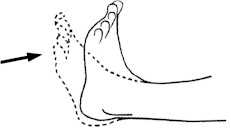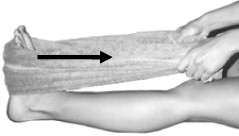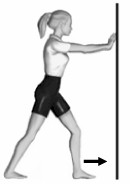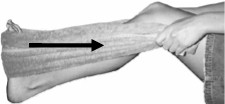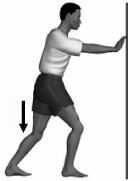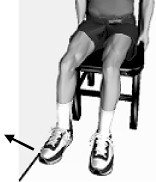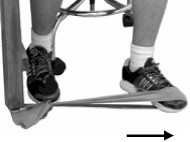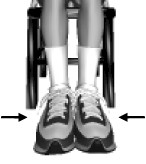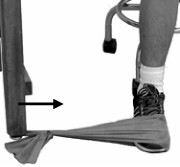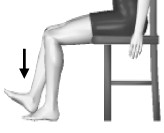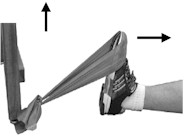Ankle Range of Motion Exercises
Help to build normal ankle motion.
Pullback
| Technique:Sit with your knee straight and hold the foot position as long as possible. Do as frequently as possible.• Flex your foot back toward your body. |
Flexibility (Stretching) Exercises Loosen tight leg muscles. Tightness makes it hard to use stairs, walk, run and jump. Technique: Hold each exercise 20seconds at a gentle stretch. Do not bounce! Frequency: 6-10 repetitions/exercise, 5-7 days per week
Calf Stretch Basic
| Technique:Sit with your knee straight and towel looped around the ball of your foot.• Slowly pull back until you feel your upper calf stretch. |
Calf Stretch Advanced
| Technique:Once you can stand, try stretching with your hands on a wall.• Place the one foot behind the other with your toes pointing forward. • Keep your heels down and back leg straight. • Slowly bend your front knee until you feel the calf stretch in the back leg. |
Heel Stretch Basic
| Technique:Sit with your knee slightly bent. Loop a towel around the ball of your foot.• Slowly pull back until you feel a stretch in the lower calf and heel. |
Heel Stretch Advanced
| Technique:Once you can stand, try placing your injured foot behind the other with your toes pointing forward.• Keeping your heels down, slowly bend your back knee until you feel a heel stretch in the back leg. |
Strengthening Exercise Strong leg muscles help the ligaments hold the ankle together. Frequency: Three sets of 20 repetitions, 5-7 days per week
Front of Shin Basic
|
Technique: – Push Out • With your foot flat on the floor, push it outward against a wall, file cabinet or bookcase. Hold for three seconds. |
Front of Shin Advanced
| Technique:– Band• Tie the band to a desk or dresser. • Sit with your foot and knee in line and loop the band over the outside of your foot. • Push your foot out against the band. |
Inner Shin Basic
| Technique:– Push In• With your foot flat on the floor, push it inward against your other foot. Hold for three seconds. |
Inner Shin Advanced
| Technique:– Band• Tie the band to a desk or dresser. • Sit with your foot and knee in line, and loop the band over the inside of your foot. • Push your foot in against the band. |
Front of Shin Basic
| Technique:– Push Up• Place the heel of your other foot on top of the injured one. • Push down with the top heel while trying to push up with the injured foot. Hold for three seconds. |
Front of Shin Advanced
| Technique:– Band• Tie the band to a desk or dresser. • Sit with your leg straight and loop the band over the top of your foot. • Slowly pull your foot back against the band. |
To Prevent Ankle Injury • Continue daily calf and heel stretching, especially after activity (indefinitely) • Continue ankle strengthening 3-4 days per week (indefinitely) • Complete the balance tests and exercises (indefinitely)
• Wear an ankle brace during strenuous activity (indefinitely)
An ankle sprain can decrease your ability to balance on that foot and makes it easier to roll the ankle. Try the balance tests below.
Balance Test If you can’t balance for ten seconds without wobbling, practice that level every day until you can. You can stop when you pass the Level 4 test.
| Technique: Balance on your left foot for ten seconds, do a least 6 repetitions per day. Then repeat for right foot. Goal: Stand 60 seconds without losing your balance, then move to the next level. Level 1 – Arms out to your side, eyes open Level 2 – Arms across your chest, eyes open Level 3 – Arms out to your side, eyes closed Level 4 – Arms across your chest, eyes closed |
Bracing Injured ligaments can take up to 16 weeks or more to heal. An ankle brace helps protect the ligaments not only during recovery but also when returning to sport or exercise activities.
Common beliefs: 1. Bracing can replace strengthening exercises – FALSE! Strong lower leg muscles help provide support to injured ligaments. 2. Wearing a brace makes an ankle weaker – FALSE, if you continue your strengthening exercises. Plus, a brace can help improve your balance and thus prevent injury. 3. Braces won’t fit in shoes – FALSE! Professional and college athletes wear them all the time.
This information has been told to me by friends, coaches and trainers over the last 25 years. but most of the wording and pictures for this paper is found on the following Web page. McKinley Health Center

